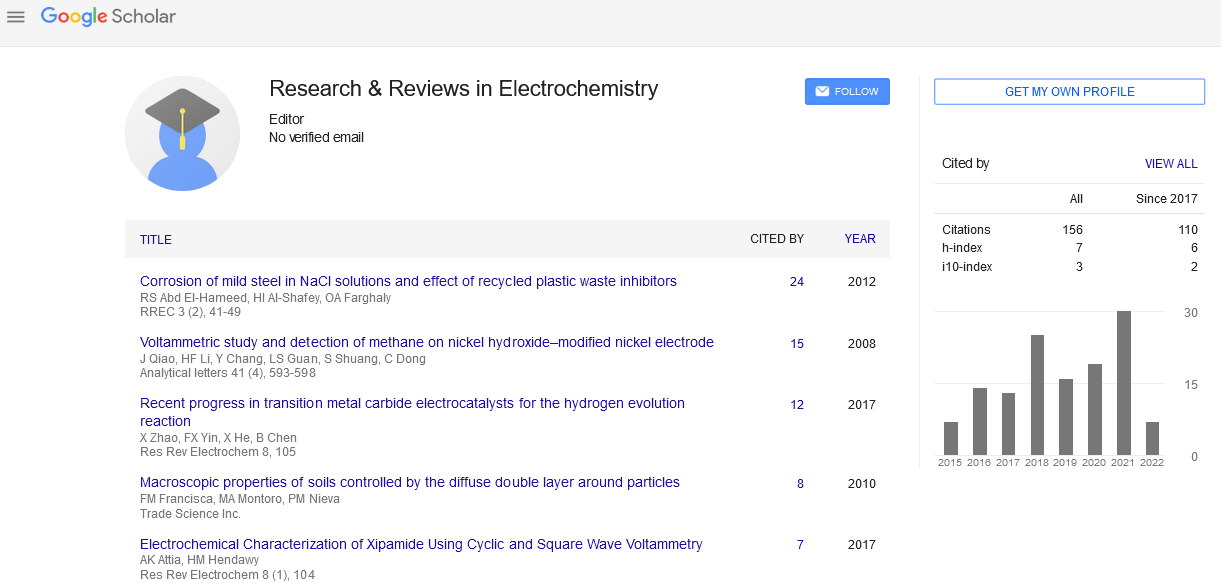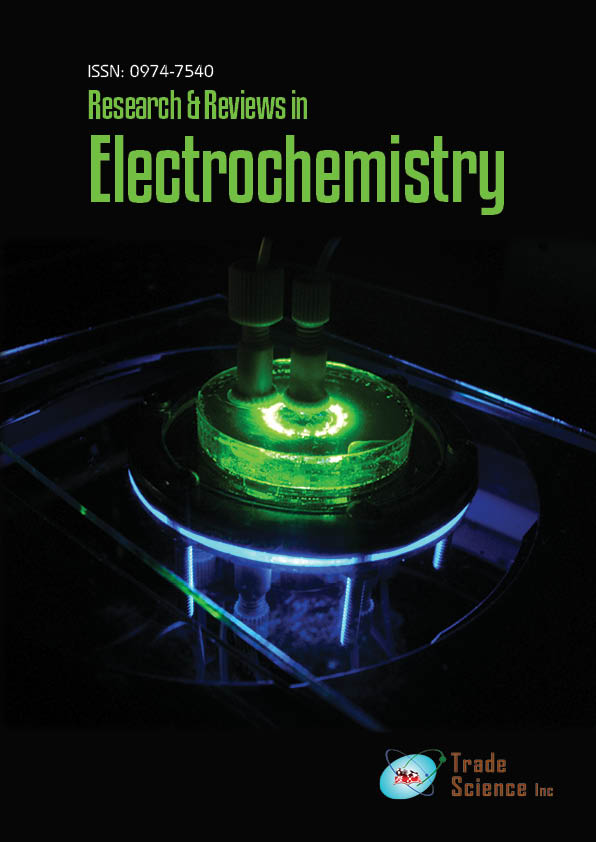Viewpoint
, Volume: 12( 1) DOI: 10.37532/0974-7540.22.12.1.232Electrochemical Process Advancements for Recycling Lead-Acid Batteries
- *Correspondence:
- James Stan
Editorial Office, Research and Reviews in Electrochemistry, UK
E-mail: publisher@tsijournals.com
Received: 2-January-2022; Manuscript No. tsrre-22-64498; Editor Assigned: 16-January-2022; PreQC No. tsrre-22-64498 (PQ); Reviewed: 24- January-2022; QC No. tsrre-22-64498 (Q); Revised: 27-January-2022; Manuscript No. tsrre-22-64498 (R); Published: 29-January-2022, DOI No. 10.37532/0974-7540.22.12.1.232
Citation: Stan J. Electrochemical Process Advancements for Recycling Lead–Acid Batteries. Res Rev Electrochem. 2022;12(1):232.
Abstract
The lead-acid battery recycling sector is well-established, but traditional pyrometallurgical techniques are far from ecologically friendly. As a result, recent advancements in lead-acid battery recycling technologies have focused on low-temperature (electro) hydrometallurgical processes, the subject of this review, which includes modified electrolytes, improved reaction engineering, better reactor design, and control of operating conditions.
Keywords
Processes of electrowinning; Lead-acid batteries; Battery recycling technologies; Pyrometallurgy
Introduction
The production of Lead-Acid Batteries (LABs) accounts for more than 85% of worldwide lead use, equal to around 10 Mt a -1 . Because of their mature, robust, and well-understood chemistry, as well as their ability to deliver bursts of power required for the starter ignition of internal combustion engines, LABs are used in almost all of the world's 1.3 billion vehicles currently in use, as well as in the construction of back-up power supplies worldwide, accounting for a global industry worth approximately 40 G£ a-1 . Furthermore, because to their proven market domination for 12 V auxiliary power sources for electrical gadgets, they are still The increasing number of automobiles and electric bicycles is directly related to rising worldwide Pb demand, causing in an unavoidable increase of wasted LABs. Although LAB recycling already accounts for more than 85% of total secondary Pb produced, current LAB recycling practises are dominated by pyrometallurgical processes with high energy consumptions and expensive gaseous and liquid pollution abatement technologies to reduce highly toxic lead emissions. The scale of secondary Pb recycling is likely to rise further due to the recent significant expansion in LAB production and consumption, with a projected annual worldwide growth rate of 3.7%. As a result, alternative low temperature hydrometallurgical technologies that offer effective and sustainable recycling solutions have been developed. This paper contrasts traditional pyrometallurgical approaches for LAB recycling with current and projected electrochemical technologies, outlining significant advances in electrolyte selection, improved reaction engineering, better reactor design, and operating condition management. Other Pb oxide precipitation and calcination-based hydrometallurgical techniques are not discussed here.
Processes for conventional pyrometallurgical lead recycling
PbO2 film cathodes, sponge metallic Pb anodes, fibre glass mat separators, and aqueous sulfuric acid electrolyte solutions are all stored in polypropylene containers in LABs. Prior to metallurgical processing, end-of-life LABs are broken, crushed, and physically separated into streams of polypropylene and polymers (5 wt% to 12 wt%), sulfuric acid electrolyte (11 wt% to 30 wt%), metallic Pb grid (24 wt% to 30 wt%), and Pb oxide/sulfate paste (30 wt% to 40 wt%). Plastic materials are often recycled, and sulfuric acid waste is transferred to an acid factory for purification. The typical amount of Pb paste from a wasted LAB is a 6 kg combination of PbSO4 (50 wt% to 60 wt%), PbO (5 wt% to 10 wt%), PbO2 (15 wt% to 35 wt%), and metallic Pb (2 wt% to 5 wt%).
To eliminate SO2 emissions during ('indirect') smelting, 'PbSO4' is de-sulfated by conversion in sodium carbonate solution to 'PbCO3', followed by thermal breakdown at around 400°C, desorption of CO2, and reduction with coke of the whole mixture to convert all Pbcontaining compounds to metallic Pb. 'Direct smelting' without de-sulfation not only emits SO2, but also has a greater specific energy consumption and creates Pb dust, ash, and other pollutants that must be treated. Nonetheless, direct smelting is still commonly used, particularly in low- to middle-income nations.
In the first step of secondary smelting, the Pb scrap is reduced by adding coke in a reverberatory or rotating furnace working at 1100°C to 1300°C. The main bullion (85% to 92% wt Pb) has minor amounts of Sb, As, and Sn, but it may be easily processed to high purity Pb appropriate for battery manufacture. In step two, a secondary lead-antimony alloy (8% to 10% wt Pb) is made from the slag that contains all of the alloying elements and impurities. This stage can be completed in the same vessel as the removal of the main Pb bullion, or in a separate tiny blast furnace. To create a marketable antimonial alloy, the alloy product requires modest refining and alloy composition alteration. If the lead level is low enough to be ecologically acceptable, the resulting slag (1% to 4% wt Pb) can be discarded. Specific environmental contamination phenomena linked with battery recycling have been widely characterised in the literature, both external and in-plant. Pyrometallurgical operations, in particular, are responsible for large emissions of heavy metals and acidic gases. The World Health Organization publishes an ambient air quality standard limit for Pb concentrations in the outdoor environment in the European Union of 0.5 g m-3 averaged over one year, however it should be emphasised that this is not a health-based norm. Dust emissions containing Pb particles endanger humans, animals, soil, and drinking water, particularly in the proximity of Pb smelting operations, which are frequently positioned near big metropolitan areas to reduce the costs associated with moving huge amounts of scrap. Despite advancements in Pb smelting technology, there is still a need for the development of cleaner and more efficient secondary Pb processes, as well as lower-cost and energyefficient methods of recovering Pb from end-of-life batteries.
Lead electrowinning chemistry
Pyrometallurgical smelting procedures currently account for more than 90% of the Pb recovered from end-of-life LABs. However, many (electro-)hydrometallurgical processes involving electrolytic conversion of dissolved PbII to high purity Pb cathodes have been proposed over the years, as they are thought to have a lower negative environmental impact due to low operating temperatures, reduced dust emissions, acceptable gaseous emissions (O2 and H2), and high flexibility. Furthermore, electrochemical deposition may be very selective, resulting in high purity (>99.9%) metal, eliminating the need for Pb refining.
Like indirect smelting methods, conventional (electro-)hydrometallurgical process strategies begin with Pb paste desulfation; sulphur in the paste is transformed into soluble sulphates by interacting with Na2CO3, NaOH, (NH4)2CO3 or NaC2O4 solutions. Byproducts of sodium sulphate, Na2SO4, are employed in numerous industrial applications. By leaching with acidic solutions such as HCl, H2SiF6, or HBF4, the insoluble product PbCO3, Pb(OH)2, or PbC2O4 is recovered and transformed to a PbII–containing solution. The PbII–rich solution is then electrolyzed to create high purity Pb, which is melted and cast into lead "pigs" suitable for the manufacture of new batteries. MacFarlane investigated the electrochemical cycling and morphology of Pb depositions from 1-ethyl-3-methylimidazolium bis(trifluoromethanesulfonyl)imide, revealing compact and non-dendritic depositions. Researcher investigated the use of a urea-based Deep Eutectic Solvent (DES) to deposit uniform sub-micrometre Pb wires, investigating the effects of temperature and current density on charge yields, specific electrical energy consumptions, and deposit morphologies, while Poll demonstrated >99.7% Pb extraction from an ethylene glycol-based DES mixture via electrodeposition. Liu reported uniform, dense, and non-dendritic Pb deposition from a ureaimidazolium DES mixture, whereas Liao investigated the electrochemical properties of water-insoluble PbSO4, PbO2, and PbO phases in urea-choline chloride DES mixtures and found similar behaviour for all Pb compounds studied. Furthermore, Chen colleagues exhibited smooth and uniform Pb deposition from Pb oxides dissolved in a protonated betaine bis((trifluoromethyl)sulfonyl)amide, a hydrophobic Brnsted acidic amide-type IL. Despite their popularity, the use of ILs raises issues such as scale availability, cost, chemical stability, recycling, and effluent treatment, as well as the question of whether anode reaction is viable.
Difficulties in developing industrial-scale lead electrowinning methods
Electrowinning processes are still considered less economically advantageous than pyrometallurgical Pb recycling processes, and are typically associated with high operating costs due to the chemical reagents required for Pb paste dissolution, as well as significant capital costs with high equipment replacement rates due to corrosion of metallic components in the electrowinning equipment. Furthermore, the presence of several insoluble/partially-soluble phases of Pb poses a significant obstacle to the technological development of Pb recycling processes, restricting production rates and capacities. Anode reaction selection/design is also of great academic interest, as avoiding PbO2 deposition is difficult yet critical to the implementation of any electrowinning technique.
We should mention that while PbO2 might be a useful secondary product, it is rarely used.
Anode materials are generally often expensive and have limited life lifetimes. Furthermore, the hazardous compounds used in these procedures pose severe health hazards to employees. As a result, even after 30 years of research and development, (electro-) hydrometallurgical processes have not been widely adopted by existing industrial units, despite increased interest and fresh investments in this sector.
Current metal industry practises in the UK are categorised as energy demanding sectors, accounting for 40% of the UK's carbon emissions from corporations and the public sector. As a result, they are vulnerable to policies aimed at mitigating climate change, potentially rendering the UK Electrical and Electronic Engineering industries sector uncompetitive with the rest of the world, especially given the lack of a common global standard for reducing carbon emissions and rising energy costs. As a result, such industries are expected to be more likely to use greener recycling solutions in the near future.
Conclusion and perspective
Because of their simple form and chemical content, wasted LABs are well-known for recycling. Because the purities of the recycled and refined Pb compounds are high enough for re-use in new LABs, recycling is critical to the LAB circular economy. Although the LAB recycling business allows for the recycling of 99% of all batteries, end-of-life LAB recycling is also the most polluting industrial process in the world. Because of the existence of unregulated informal recycling, efficient management and growth of the LABs recycling industry is extremely difficult. While Pb exposure and emission rates are tightly managed and regulated in developed nations, they are much greater in low-to-medium income countries. Because of its basic structure and chemical makeup, used LABs are easily recycled. The purities of the recycled and refined Pb compounds are high enough for reuse in new LABs, making recycling critical to the LAB circular economy. Although the LAB recycling business allows 99% of all batteries to be recycled, end-of-life LAB recycling is also the most polluting industrial process in the world. Due to the existence of unregulated informal recycling, efficient management and growth of the LABs recycling industry is extremely difficult. While Pb exposure and release rates are tightly managed and regulated in developed nations, they are significantly greater in low-to-medium income countries. This has resulted in lead exposure and poisoning; for example, during the previous decade, 10 major lead poisoning incidents have been documented in China, while an examination of workers in a Kenyan smelter indicated blood lead levels more than six times higher than generally permissible. As a result, there is an urgent need for research and development of unique and better recycling techniques that are energy efficient, environmentally friendly, and cost effective, hence ensuring the long-term viability of battery technologies.

